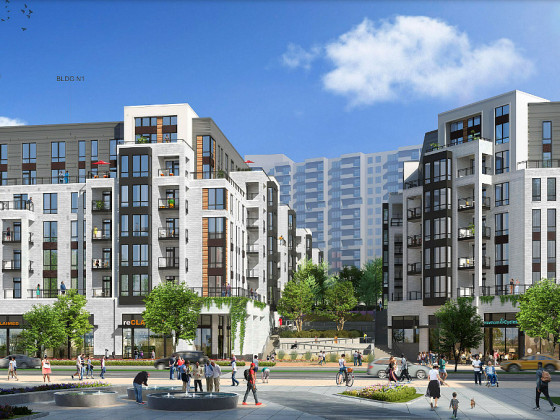 Primer on DC Neighborhoods (for Brooklyn Transplants), Part 2
Primer on DC Neighborhoods (for Brooklyn Transplants), Part 2
✉️ Want to forward this article? Click here.
This is the second article of our two-part series profiling the DC neighborhoods we feel would most interest folks moving to Washington from Brooklyn. The idea for this series came from the response we got after publishing an article that compared condo prices in DC to those in Brooklyn. It seems that, Obama-itis aside, a lot of people are now making the move from this New York City borough down to DC. If you haven’t already, make sure to check out Part 1 as well, which profiles Dupont Circle, Georgetown, Logan Cirlce, and H Street.

18th Street in Adams Morgan
An eclectic area of bars, cafes, and ethnic restaurants, Adams Morgan is one of DC’s liveliest neighborhoods. The main commercial corridor of 18th Street is lined with places to eat and drink, and the side streets offer both row houses and apartment buildings as potential living options. The neighborhood has developed a reputation for its weekend nightlife scene when revelers pack the bars until 2am then pour into the streets en masse in search of a cab, a jumbo slice, or, sometimes, a fight. Those who enjoy the scene swear by it; those who don’t, swear at it. Anyone considering living in Adams Morgan should definitely check it out at 2am on a Friday or Saturday night to see if they can tolerate the mayhem, noise, and occasional ugliness. During the week things are calm, which means neighborhood residents have some of the best bars in the city all to themselves. While Adams Morgan technically is on the Metro, in reality the station is a bit of a walk from the neighborhood core. (Also see our comprehensive real estate profile of Adams Morgan.)

Election Night on U Street
U Street Corridor
A lot has been made of U Street’s African-American roots. It was the country’s epicenter of black popular culture before being overtaken by Harlem in the 1920s. In 1968, it was the site of one of three riots that rocked Washington following the assassination of Martin Luther King, Jr, after which the whole neighborhood fell into decline and the intersection of 14th and U became one of the city’s most notorious. Fast forward to the late 90s when redevelopment and gentrification began, and the area started coming back. Today it is considered one of the most dynamic neighborhoods in the city. Restaurants, cafes, bars, and condos stretch from 9th Street all the way up to 18th Street, with more to come. It appeals to a diverse group of DC residents while still retaining its strong legacy as Black Broadway. As for the intersection of 14th and U, it was the site of a spontaneous and joyous street celebration on the night of Barack Obama’s election, a fitting moment for a revitalized and proud neighborhood.

14th & Irving in Columbia Heights
Nowhere is DC’s gentrification more pronounced these days than Columbia Heights, the neighborhood north of the U Street Corridor and east of Adams Morgan. Just a few years ago, there was little to draw non-residents to the neighborhood. Now there is a shiny new retail center with a Target, Best Buy, Marshall’s, and Bed, Bath, and Beyond. The center, called DCUSA, is something of an anchor for the neighborhood, whose demographics are split pretty evenly among Latino, black, and white. Many young professional transplants choose to live in Columbia Heights because rent is still cheaper than in more established neighborhoods. The neighborhood is also home to Wonderland, a veritable institution among DC’s hipster set. (See our comprehensive real estate profile of Columbia Heights.)

Petworth’s Grant Park
Just north of Columbia Heights is Petworth, considered by many to be DC’s next frontier of gentrification. The neighborhood has blocks upon blocks of its signature porched row houses, and residents tout its neighborhood-y feel. Many newcomers to Petworth opt to live close to the intersection of Georgia and New Hampshire Avenues, where the Metro station and small-but-growing commercial strip are found. The Petworth of today is often compared to the Columbia Heights of earlier this decade, when that neighborhood was in the nascent stages of transition. If Petworth’s trajectory does end up following that of Columbai Heights, big changes are in store for the neighborhood. One important question is whether the current economic climate will slow development down by a few years. For a daily briefing on Petworth’s quirks and goings-on, follow the Prince of Petworth, arguably the most popular neighborhood blog in the city. (Also see our comprehensive real estate profile of Petworth.)
This article originally published at https://dc.urbanturf.com/articles/blog/primer_on_dc_neighborhoods_for_brooklyn_transplants_part_2/488.
Most Popular... This Week • Last 30 Days • Ever

UrbanTurf takes a look at the options DC homeowners and residents have to take advant... read »

A major new residential development is on the boards for a series of properties near ... read »

A new report from DC’s Office of Revenue Analysis highlights how millennials and wo... read »

The building is the second proposal for a pair of aging office buildings in downtown ... read »

The central action before the Board is a rezoning request for the nearly 36-acre site... read »
- A Solar Panel Primer for DC Residents
- 29-Story, 420-Unit Development Pitched For Middle Of Downtown Bethesda
- How DC's Population Changed During And After The Pandemic
- Fitting In: A Narrow 260-Unit Apartment Building Pitched For Bethesda
- Arlington County To Weigh Major Actions Advancing RiverHouse Redevelopment
DC Real Estate Guides
Short guides to navigating the DC-area real estate market
We've collected all our helpful guides for buying, selling and renting in and around Washington, DC in one place. Start browsing below!
First-Timer Primers
Intro guides for first-time home buyers
Unique Spaces
Awesome and unusual real estate from across the DC Metro














